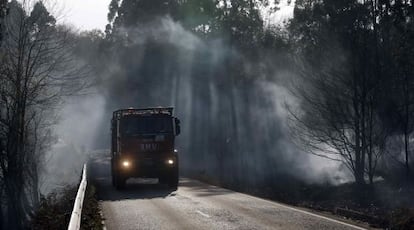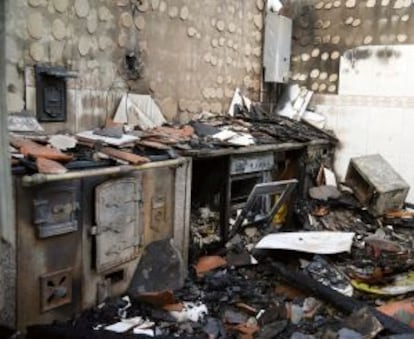What caused northern Spain’s weekend wave of forest fires?
The sheer number of blazes that have hit Asturias and Cantabria is unprecedented


Around 2pm on Saturday afternoon, the cloud of smoke moving in from the south at full speed was so huge that it covered up the sun.
Cecilia Pérez, mayor of El Franco – one of the municipalities that has been worst hit by the scores of fires that affected the northern Spanish regions of Asturias and Cantabria at the weekend – understood the magnitude of what was coming.
She phoned the mayor of Boal, where the fire started, and the emergency services. Soon after that, teams that included military personnel showed up to start battling the elements: southerly winds that fanned the flames, oddly high temperatures for this time of year, and dry vegetation caused by a lack of rain in what is normally one of Spain’s wettest and greenest areas.
What’s odd about this latest wave of blazes is that it happened much earlier in the season than usual
Fortunately, the rain finally started coming down on Sunday and the wind stopped blowing. The hydroplanes were able to take off, and by Monday afternoon the worst was over.
Sitting inside an emergency center erected behind the town hall in the Asturian town of La Caridad, Mayor Pérez points at a map to show the 3,500 hectares of affected land. In all, around 150 fires had broken out in the small regions of Asturias and Cantabria, with a few more registered in Galicia, Navarre and the Basque Country.
Winter fires are not all that rare in northern Spain, where they sometimes start when people burn piles of brush to clear their grazing land, explains Virginia Carracedo, a researcher at Cantabria University.
What’s odd about this latest wave of blazes is that it happened much earlier in the season than usual. Forest fires typically rage in February or March, when the snow has dried out.

The sheer number of them in such a short period of time is also unprecedented, says Captain Salvador Ortega, of the Civil Guard’s Seprona nature protection service. His department has launched an investigation into the case.
“The report we did on the wave of fires in Galicia in 2006 took a year to draft, and concluded that there was no link between them except maybe for the pull effect,” says Ortega. “Recidivism among arsonists is quite common.”
Many people have already voiced their opinion that at least some of the fires were deliberately started. These include the Asturian government’s chief of staff, Guillermo Martínez, who said on Saturday that “everything seems to indicate” that some of the fires did not have natural causes.
In any case, the speed at which the blazes advanced was “very surprising,” says José Rodríguez Hernández, a 59-year-old cattle breeder. Some of his cows were still covered in soot from the recent fire, and he is living with his sister after the flames engulfed his home in El Franco. “I’d never seen anything like it, it was like all of Asturias had burnt down,” he said.
A few hundred meters from what is left of his house, on the other side of a valley, sits another burnt property standing in the middle of a skeleton forest of burnt pine trees and rising smoke plumes.
The house belongs to Manuel Méndez, 75, who had been living there since 1952.
I’d never seen anything like it, it was like all of Asturias had burnt down” Cattle farmer José Rodríguez Hernández
“I had a little dog who was as good as can be; he must be somewhere in there, among the rubble,” he sighs. “It was a miracle that I got out alive – I suddenly found myself surrounded by flames, I almost couldn’t breathe. Good thing it occurred to me to get in the car and roll down the embankment until I was halfway down the valley, rather than going towards the road.”
There he waited all Saturday until someone came to pick him up.
“I don’t know what happened, but there were gusts of wind of up to 120km/h that were sending sparks 600 meters away,” says the mayor Cecilia Pérez. “Maybe that’s why there were so many fires. In any case, it’s all very odd. I don’t want to speculate, but I don’t think that everyone suddenly decided to go out and burn their crop residue at the same time.”
The practice of field burning to prepare the land for grazing is an old tradition in this region. But sometimes it is done without proper controls, and even when the necessary permits have been secured, weather conditions might not be propitious.
“What’s undeniable is that winter fires are on the rise in recent years,” says Pérez. “In Asturias they have stabilized, and in Cantabria they are growing.”
English version by Susana Urra.
Tu suscripción se está usando en otro dispositivo
¿Quieres añadir otro usuario a tu suscripción?
Si continúas leyendo en este dispositivo, no se podrá leer en el otro.
FlechaTu suscripción se está usando en otro dispositivo y solo puedes acceder a EL PAÍS desde un dispositivo a la vez.
Si quieres compartir tu cuenta, cambia tu suscripción a la modalidad Premium, así podrás añadir otro usuario. Cada uno accederá con su propia cuenta de email, lo que os permitirá personalizar vuestra experiencia en EL PAÍS.
¿Tienes una suscripción de empresa? Accede aquí para contratar más cuentas.
En el caso de no saber quién está usando tu cuenta, te recomendamos cambiar tu contraseña aquí.
Si decides continuar compartiendo tu cuenta, este mensaje se mostrará en tu dispositivo y en el de la otra persona que está usando tu cuenta de forma indefinida, afectando a tu experiencia de lectura. Puedes consultar aquí los términos y condiciones de la suscripción digital.
More information

Forest fires that burnt through Cantabria this weekend put out
Últimas noticias
Sydney Sweeney, the actress praised by Trump: ‘Women are up against what society wants them to be’
The Bolsonaro surname: An advantage or liability in Brazil’s 2026 presidential elections?
Raúl Rocha, from jet-setting with Miss Universe to arms trafficking and fuel theft
80,000 barrels of Mexican oil sent to Cuba: Havana drawn into the US–Mexico clash
Most viewed
- Reinhard Genzel, Nobel laureate in physics: ‘One-minute videos will never give you the truth’
- Pablo Escobar’s hippos: A serious environmental problem, 40 years on
- Charles Dubouloz, mountaineering star, retires at 36 with a farewell tour inspired by Walter Bonatti
- Why we lost the habit of sleeping in two segments and how that changed our sense of time
- The fall of a prolific science journal exposes the billion-dollar profits of scientific publishing








































